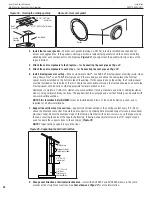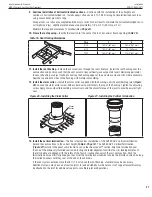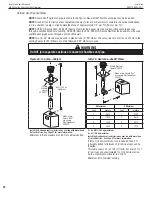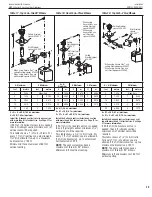
Installation
900378-00 04/2017
Innovative Hearth Products
MHD35 Series Direct-Vent Gas Fireplaces
40
Secure all joints tightly using appropriate tools and sealing compounds (ensure propane resistant compounds are
used in propane applications). Optionally, seal around the gas line to prevent cold air leakage. Gas line holes and
other openings can be caulked or stuffed with unfaced fi berglass insulation.
All codes require a shutoff valve mounted in the supply line. The orientation of the shutoff valve should face the
front.
Figure 37, page 39
illustrates two methods for connecting the gas supply. A sediment trap is recommended to
prevent moisture and debris in the gas line from damaging the valve.
Test Factory and Field Connections for Gas Leaks
WARNING
Never use an open fl ame to check for leaks.
Turn on gas supply and test for gas leaks, using a gas leak test solution—also known as bubble leak solution.
NOTE:
Using a soapy water solution is an effective leak test solution but it is not recommended, because the soap
residue that is left on the pipes/fi ttings can result in corrosion over time.
NOTE:
Remove all shipping foam on either side of the front lintel protecting the ceramic panels. Ceramic panels are
fragile - take care when handling.
1.
Light the fi replace (refer to the lighting instructions label in the control compartment or
Page 64
)
.
2.
Brush all joints and connections with the gas leak test solution to check for leaks. If bubbles are formed, or
gas odor is detected, turn the gas control knob (OFF/PILOT/ON) to the OFF position (millivolt units), or turn the
receiver or remote control to the OFF position (electronic units). Either tighten or refasten the leaking connection,
and then retest as described above.
3.
When the gas lines are tested and leak free, rinse off the leak testing solution
13.
Verify Proper Fireplace Operation
1.
With the gas line installed, inspect the system before closing the front of the unit.
2.
Follow the pilot lighting instructions:
• Millvolt
Systems
(
Page 64
)
NOTE:
When lighting the fi replace for the fi rst time, it will take a few minutes for the gas line to purge itself of air.
When purged, the pilot and burner will light and operate as indicated. Subsequent lighting of the fi replace will not
require purging. Inspect the pilot fl ame (carefully remove logs, if necessary).
Millivolt Fireplace Inspection
The pilot fl ame should be steady, not lifting or fl oating. Flame should be blue in color with traces of orange at the
outer edge. The top 3/8” (10 mm) at the pilot generator (thermopile) and the top 1/8” (4 mm) minimum (tip) of the
quick drop out thermocouple should be engulfed in the pilot fl ame. The fl ame should project 1” (26 mm) beyond the
hood at all three ports
(
Figure 38
)
. Replace the logs if removed for pilot inspection.
To light the burner, turn ON the remote wall switch and rotate the gas valve control knob counterclockwise to the ON
position (the top of the valve).
Figure 38 - Millivolt Pilot
14.
Firebox Liner Information
1.
See
Page 53
for instructions on
Traditional Only: Firebox Liners
.
NOTE:
Remove all shipping foam on either side of the front lintel protecting the ceramic panels. Ceramic panels are
fragile - take care when handling.
Thermocouple
Hood
Igniter rod
3/8” (9 mm)
min
Thermopile
Pilot
nozzels






























